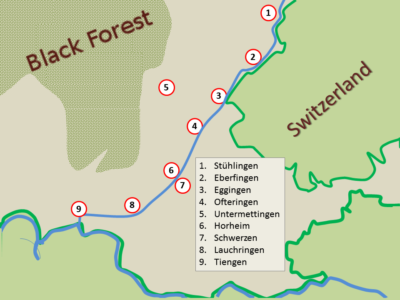3-1
¶ 41 Leave a comment on paragraph 41 0 The political geography of the region was unbelievably complicated and intermingled in the seventeenth and eighteenth centuries, forming a confusing patchwork of counties, baronies, and independent entities. Stühlingen itself originated as the dominion of a small, local noble house, Lupfen,4 and became the property of the house von Pappenheim5 for forty years, eventually forming part, by 1639, of the scattered von Fürstenberg holdings. Tiengen and its surroundings formed the Landgraviate of Klettgau, which belonged in the early seventeenth century to the counts of Sulz.
¶ 42
Leave a comment on paragraph 42 0
 Figure 5. Map of Stühlingen and the Wutach Valley
Figure 5. Map of Stühlingen and the Wutach Valley
¶ 43 Leave a comment on paragraph 43 0 The seven villages between Stühlingen and Tiengen, place of residence for many Stühlingen Jews, formed a constant bone of contention for ownership and control between the rulers of Stühlingen in the north, the counts of Sulz in the south, and the abbey of St. Blasien in the west (fig. 5). Besides Stühlingen and Tiengen, a series of Jewish communities were lined up further along the upper Rhine all the way to Lake Constance and beyond. The village of Gailingen and the little town of Aach were ruled by the counts of Nellenburg; Randegg belonged to the barons of Hegau; Worblingen was owned by the barons of Danketschweil, and Wangen by the barons of Marbach and Wangen. But all of them, in turn, were part of Further Austria, property of the Habsburg emperors.
¶ 44 Leave a comment on paragraph 44 0 Further Austria, of which Hohenems was also a part, served as a common umbrella for many other regions of Jewish settlement as well, including Burgau in Bavarian Swabia. This common administrative link fostered a bond among these Jewish settlements. Jews received letters of protection in Gailingen6 and Randegg (1656),7 Aach (1551),8 Wangen (1611),9 Worblingen (1655),10 and Hohenems (1617).11
4Brandeck, “Geschichte der Stadt.”
5Häusler, Stühlingen: Vergangenheit und Gegenwart.
6Roming, “Geschichte der jüdischen Gemeinde Gailingen,”; Hundsnurscher and Taddey, “Die jüdischen Gemeinden in Baden”.
7Moos, “Geschichte der Juden im Hegaudorf Randegg”; Rosenthal, “Heimatgeschichte der badischen Juden”, 164.
8Rosenthal, “Heimatgeschichte der badischen Juden”, 79.
9Hundsnurscher and Taddey, “Die jüdischen Gemeinden in Baden”.
10Graf and Zöhren, “Jüdische Vergangenheit in Worblingen”; Hundsnurscher and Taddey, “Die jüdischen Gemeinden in Baden”, 301.
11Tänzer, “Geschichte der Juden in Tirol und Voralberg”, 29.

Comments
0 Comments on the whole Page
Login to leave a comment on the whole Page
0 Comments on paragraph 41
Login to leave a comment on paragraph 41
0 Comments on paragraph 42
Login to leave a comment on paragraph 42
0 Comments on paragraph 43
Login to leave a comment on paragraph 43
0 Comments on paragraph 44
Login to leave a comment on paragraph 44
0 Comments on paragraph 45
Login to leave a comment on paragraph 45
0 Comments on paragraph 46
Login to leave a comment on paragraph 46
0 Comments on paragraph 47
Login to leave a comment on paragraph 47
0 Comments on paragraph 48
Login to leave a comment on paragraph 48
0 Comments on paragraph 49
Login to leave a comment on paragraph 49
0 Comments on paragraph 50
Login to leave a comment on paragraph 50
0 Comments on paragraph 51
Login to leave a comment on paragraph 51
0 Comments on paragraph 52
Login to leave a comment on paragraph 52